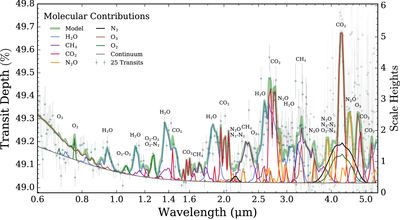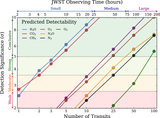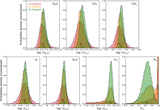Image Details

Caption: Figure 2.
Molecular contributions to the transmission spectrum of an Earth-like exoplanet orbiting WD 1856+534. We display the best-fitting transmission spectrum retrieved from a simulated 25-transit JWST program (green shading). The opacity contributions of each retrieved molecule (colored curves) are shown, relative to the spectral continuum due to Rayleigh scattering and refraction (gray curve). Prominent absorption features are labeled. Collision-induced absorption (CIA) pairs featuring O2 (O2–O2 and O2–N2) are depicted alongside the O2 contribution. N2–N2 CIA provides a contribution around 4 μm. All contributions are plotted at R = 100 for ease of comparison with the simulated JWST observations (error bars). The number of equivalent scale heights (H ≈ 8.8 km) above the surface, for which an opaque atmosphere at a given wavelength would produce the same transit depth, is shown on the right. For such observations, H2O, CO2, CH4, and O3 are confidently detected to >5σ confidence, N2O to >4σ, and O2 to >2σ.
Copyright and Terms & Conditions
© 2020. The American Astronomical Society. All rights reserved.






